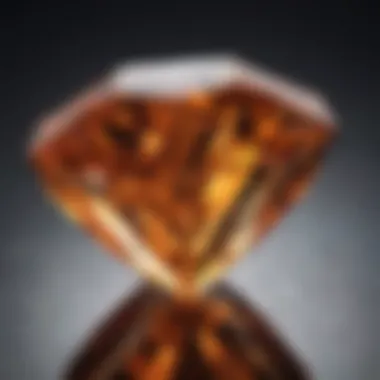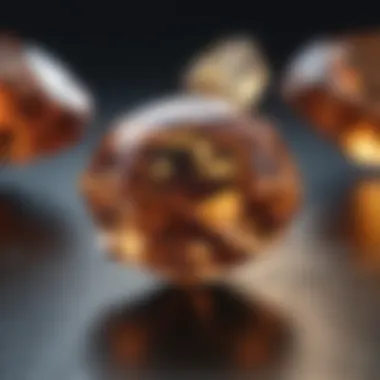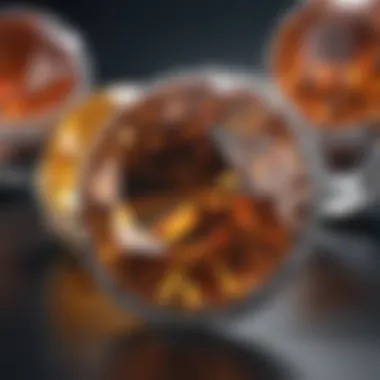Understanding the Value of Topaz: Key Insights


Intro
Topaz is among the most prized gemstones globally. Its allure spans centuries, appealing to collectors, jewelry designers, and enthusiasts alike. However, determining its true value involves understanding several factors. This article aims to break down these elements, focusing on both the intrinsic characteristics of the topaz and the market dynamics that drive its worth.
Gemstone Overview
Description of the gemstone
Topaz is a silicate mineral composed of aluminum and fluorine. It is known for its wide range of colors, including blue, yellow, orange, and colorless varieties. The most sought-after shades often include the deep blue and golden yellow. The stone's clarity and brilliance contribute significantly to its desirability.
Physical properties
Topaz has notable physical properties that contribute to its value:
- Hardness: It ranks 8 on the Mohs scale, making it durable and suitable for various types of jewelry.
- Luster: The gemstone displays a vitreous luster, which enhances its visual appeal.
- Transparency: High-quality topaz can be completely transparent, allowing light to pass through, enhancing its brilliance.
- Crystal structure: It typically forms in orthorhombic crystals, which are often well-developed and can be quite large, adding to its rarity.
Healing Properties
Metaphysical attributes
Many believe that topaz possesses metaphysical properties. It is often associated with qualities like calmness, creativity, and strength. Throughout history, it has been thought to promote mental clarity and emotional stability. Such attributes attract individuals interested in gemstones for their healing properties.
Common uses in holistic practices
In holistic practices, topaz is used in various ways. Here are some common applications:
- Meditation: Practitioners use topaz to enhance concentration and focus during meditation.
- Energy healing: It is believed to help cleanse negative energies from the body.
- Chakra balancing: Many use topaz to align and balance chakras, particularly the solar plexus chakra.
"Topaz is not only appreciated for its beauty but also for the emotional and physical benefits it may bring."
The growing interest in the metaphysical aspects of gemstones has led more people to explore the value of topaz from this perspective. Understanding these properties can also add another layer to its valuation in the market.
Prologue to Topaz
Topaz is a gemstone that carries significant allure in both the jewelry and geological communities. Understanding its value is crucial for gemstone enthusiasts, collectors, and jewelry designers alike. The importance of topaz lies not only in its beauty but also in its diverse qualities and market dynamics. This section seeks to illuminate the factors behind topaz’s worth and its intricate journey from geological formation to prized possession.
Historical Background
Topaz's history stretches back thousands of years. The gemstone has been associated with various cultures and has held different meanings throughout time. Ancient civilizations often attributed protective qualities to topaz, believing it could protect wearers from outside forces. For instance, the Egyptians valued topaz as a symbol of protection and healing. They associated the stone with the sun god, Ra, which illustrates its esteemed place in ancient societies.
The name "topaz" is thought to derive from the Sanskrit word "tapaz," meaning fire. This etymology reflects the gemstone's captivating colors and brilliance. As trade routes expanded in the Middle Ages, topaz became increasingly popular in Europe. Jewelers began to exploit its versatility, crafting stunning pieces for royalty. The rich historical narrative around topaz adds a layer of appreciation for anyone looking into its value.
Geological Formation
Understanding the geological formation of topaz is fundamental for assessing its quality and origin. Topaz usually forms in igneous rocks, particularly those rich in aluminum and fluoride. Hot vapors emanating from cooling magma often lead to the crystallization of topaz. This unique formation process can yield a diverse range of colors. Notably, topaz can be colorless, yellow, blue, pink, or even a rare imperial shade that is highly sought after.


The local geology plays a significant role in shaping the characteristics of topaz. Different regions produce unique varieties. The best quality topaz often comes from Brazil, with blue topaz from Texas as another notable source. Understanding where a topaz stone is sourced can significantly influence its market value. Expertise in geological formation not only promotes better buying decisions but also enhances the overall appreciation of this remarkable gemstone.
Topaz Characteristics
Understanding the characteristics of topaz is essential for appreciating its value in the gemstone market. Topaz is known for its distinctive features, which can significantly influence its pricing and desirability. The key elements to consider include color varieties, clarity and cut, and carat weight. Each of these aspects plays a vital role in determining the appeal of a topaz gemstone, ultimately guiding both buyers and sellers in making informed decisions.
Color Varieties
Topaz displays a remarkable range of colors, which include colorless, blue, yellow, orange, pink, and even red hues. The most common color is blue, attributed mainly to treatments that enhance the stone's natural characteristics. The presence of certain impurities contributes to other color variations. The intensity and saturation of these colors are also crucial. More vivid colors usually command higher prices. Therefore, understanding the different color varieties is important for collectors. The color of a topaz gemstone can affect not only its aesthetic appeal but also its market value.
Clarity and Cut
Clarity and cut are fundamental factors in assessing the quality of topaz. Clarity refers to the internal and external flaws of a gemstone, which can impact its beauty. Ideally, a topaz gemstone should be free from visible inclusions. The cut of the gemstone affects how light interacts with it, which can enhance or diminish its brilliance. A well-cut topaz will reflect light effectively, while a poor cut may result in decreased luster. Buyers should be mindful of both clarity and cut when considering a purchase. These elements significantly influence a stone's overall appearance and price.
Carat Weight
Carat weight is another significant factor that affects topaz pricing. Generally, larger stones are rarer and thus more valuable. However, the relationship between carat weight and price is not linear. As the carat weight increases, the price tends to rise sharply. Buyers should consider not only the carat weight but also how it interacts with color and clarity. While a larger stone might seem attractive, its overall value will also factor in its quality. Understanding this balance is essential for making well-informed purchasing decisions.
"The characteristics of a gemstone significantly contribute to its market value, making them essential for both buyers and sellers to understand."
In summary, exploring the characteristics of topaz sheds light on what influences its value. The interplay of color varieties, clarity and cut, and carat weight all contribute to the gemstone's market narrative. Knowing these aspects equips individuals with the knowledge to navigate the complex gemstone market.
Market Value of Topaz
The market value of topaz is crucial for understanding its significance as a gemstone. It encompasses not only the numerical worth but also the considerations that affect trading and collection. The various elements within the market value illustrate the processes that inform buyers and sellers, making it essential for anyone engaged with gemstones.
Global Market Overview
The global market for topaz reflects both its current popularity and potential for investment. Countries like Brazil, Nigeria, and Russia contribute significantly to the production of this gemstone. The demand for topaz remains strong, particularly for the blue and imperial varieties. In retail, the presence of online platforms has transformed how gems are bought and sold, allowing broader access to collectors.
Factors such as economic conditions, fashion trends, and consumer preferences all influence the global appeal of topaz. Awareness of these dynamics can assist stakeholders in making informed decisions. As awareness of sustainability grows, ethically sourced stones gain traction, impacting market prices and availability.
Supply and Demand Dynamics
The supply and demand dynamics surrounding topaz dictate its pricing structure. The availability of quality stones can directly influence market prices. As more buyers enter the market, the competition increases. This often leads to higher prices for rarer varieties.
- Increased consumer interest in unique colors, such as the rare pink topaz, has led to growth in demand.
- Fluctuations in mining yield impact supply levels. Mining operations can be subject to environmental regulations, which may restrict output.
- Economic stability in producing countries can affect exportation, influencing supply.
Understanding these dynamics allows buyers to gauge when to invest or sell, maximizing their returns while navigating potential market instability.
Price Fluctuations Over Time
Price fluctuations in topaz are informed by various historical and current factors. Generally, the value of topaz has seen a gradual increase over the years. However, certain periods have presented considerable volatility.
Examining price trends can reveal patterns:
- Market Events: Global jewelry exhibitions often spark increased interest, temporarily boosting prices.
- Global Crises: Economic downturns and political instability may negatively affect purchases, leading to price drops.
- Technological Advances: Enhanced mining techniques and gemstone treatments can alter perceived value.


Price trends highlight the importance of ongoing market assessments for anyone interested in topaz investments.
In summary, comprehending the market value of topaz, including its global overview, supply and demand dynamics, and price fluctuations, equips both buyers and sellers with the insights needed to navigate this complex market effectively.
Factors Influencing Topaz Pricing
Understanding the factors that influence topaz pricing is crucial for anyone invested in the gemstone market. Pricing is not just determined by a fixed set of rules; it incorporates a variety of components, each intertwined with its own nuances. When buyers comprehend these factors, they can make more informed decisions and potentially enhance their investments.
Quality Assessment
Quality plays a vital role in determining the price of topaz. Various attributes contribute to this assessment, including color, clarity, cut, and carat weight.
- Color: Topaz comes in a range of colors such as blue, yellow, pink, and colorless. The most sought-after varieties, particularly the deep blue or imperial pink topaz, often command premium prices.
- Clarity: Like other gemstones, the clarity of topaz significantly impacts its value. Stones that are free from inclusions and possess high transparency are valued higher.
- Cut: This refers to how well the gemstone has been shaped and polished. A high-quality cut enhances the gemstone's brilliance and can elevate its worth drastically.
- Carat Weight: Larger stones, generally those exceeding five carats, can fetch much higher prices per carat compared to smaller variants, mainly due to their rarity.
These quality factors create a framework for pricing that is both complex and varied.
Origin and Source
The origin of topaz can affect its market value substantially. Gems from specific locations may have higher prestige and demand. Some key aspects include:
- Geographical Significance: Topaz from particular regions, such as Brazil or the Ural Mountains in Russia, can be more desirable. The reputation of a source can add inherent value to the stone.
- Mining Regulations: The methods and regulations surrounding mining in a region can also influence prices. Environmentally-friendly and sustainable operations tend to appeal to eco-conscious buyers, potentially elevating the worth of their gemstones.
Buyers often seek assurance regarding the provenance of their topaz, which can assure them of the quality and value.
Market Perception
Perceptions within the market can dictate prices just as much as inherent qualities of the stones. This aspect is often shaped by:
- Trends in Fashion and Use: The popularity of certain gemstones can fluctuate based on current trends in jewelry and design. For instance, if a particular cut becomes popular, demand for that style may surge, impacting prices.
- Cultural Significance: In some cultures, particular gemstones are perceived to carry spiritual or healing properties. This perception can drive market interest and subsequent pricing.
- Marketing and Branding: The branding of topaz by jewelers and designers can significantly impact consumer perception. Marketing campaigns can heighten interest in certain types of topaz or styles, influencing pricing.
Thus, understanding these market dynamics provides valuable insight into how pricing is established and can fluctuate over time.
"Knowledge of gemstone valuation not only enriches the collector's experience but also serves as a strategic advantage in making purchasing decisions."
Comparative Analysis
Understanding the comparative analysis of topaz against other gemstones is essential for anyone interested in the gemstone market. This analysis enables potential buyers and sellers to evaluate where topaz stands relative to more well-known gemstones like diamonds, sapphires, and emeralds. Each gemstone brings its unique characteristics, which influence its demand and value. By contrasting these elements, one can make informed decisions.
Topaz Versus Other Gemstones
Topaz is often compared with other widely recognized gemstones, including diamonds and sapphires. The comparison typically involves aspects such as durability, aesthetic appeal, and market demand.
- Durability: Topaz is rated 8 on the Mohs hardness scale, making it quite durable. In contrast, sapphire and diamond rank higher at 9 and 10, respectively. This factor influences topaz's suitability for various jewelry applications.
- Aesthetic Appeal: The color varieties of topaz can intrigue collectors. Blue, yellow, and pink shades are particularly sought after. However, diamonds are often deemed the most desirable due to their brilliance and rarity.
- Market Demand: The demand for gemstones fluctuates based on trends. Diamonds often dominate the luxury market but topaz has found its niche particularly among those seeking unique colored gemstones without the price tag of more expensive options.
"Understanding the position of topaz in the gemstone hierarchy aids buyers in making choices aligned with their preferences and budget."
Investment Value


When evaluating topaz from an investment perspective, several factors come into play. Investing in gemstones can be appealing due to their potential for appreciation.
- Market Trends: The market for colored gemstones, including topaz, has grown. This shift reflects a broader interest in alternative investments and the quest for unique pieces.
- Rarity and Demand: While topaz is not as rare as some other gemstones, specific colors or cuts may fetch a higher price. Collectors often seek out limited-edition or unique varieties, which can lead to appreciation in value.
- Long-Term Potential: Investing in topaz can be a sound choice for those looking to diversify their portfolio. As knowledge about colored gemstones increases, so does the opportunity for price increase over time.
Practical Insights for Buyers
Understanding the intricacies of topaz is essential for anyone interested in purchasing this gemstone. The gemstone market can be complex, with myriad factors that can influence both the value and quality of topaz. Buyers armed with knowledge are more likely to make informed decisions, securing genuine pieces that reflect authenticity and beauty. This section will provide practical insights, focusing on key considerations every buyer should be aware of when approaching the acquisition of topaz.
Tips for Authenticity Verification
Ensuring that the topaz you buy is genuine is pivotal. The market has seen an increase in the prevalence of synthetic or treated stones that can significantly alter value perceptions. Here are some tips to verify authenticity:
- Look for Certifications: Reliable sources will often provide certification from recognized gemological institutions. Always request paperwork that verifies the gemstone's authenticity.
- Examine Clarity and Bubbles: Natural topaz may show inclusions, while synthetic variants are often flawless. Examining closely for bubbles or unusual features can give clues to authenticity.
- Check for Color Consistency: Natural topaz displays a range of color due to geological conditions. Inconsistency in color might suggest treatment or artificial enhancement.
- Consult with Experts: If in doubt, seek the opinion of a gemologist who can conduct an in-depth examination and provide insights on the legitimacy of the topaz.
Purchasing Decisions
When it comes to buying topaz, it is crucial to make decisions based on thorough research. Here are factors to consider:
- Vendor Reputation: Always buy from reputable dealers. Online platforms and marketplaces may offer topaz, but authenticity can vary widely. Research the seller’s history and reviews.
- Comparative Pricing: Understanding the pricing structure of topaz can help you assess whether you are getting a fair deal. Compare prices from multiple vendors, considering factors like quality and cut.
- Understand Your Preferences: Identify if you are looking for topaz as a gemstone for jewelry, investment, or collection purposes. Different uses may focus on varying factors, such as carat weight or clarity.
- Ask for Return Policies: Always inquire about return policies or guarantees. A reputable seller will offer a reasonable return window if the topaz does not meet your expectations.
Caring for Topaz
Proper care and maintenance extend the lifespan and beauty of your topaz. Here are some guidelines:
- Cleaning: Use a non-abrasive cloth to clean topaz. Mild soap with warm water is safe, while harsh chemicals should be avoided as they can damage the stone.
- Storage: Store your topaz in a soft pouch or separate compartment to prevent scratches from contact with other stones.
- Avoid Extreme Temperature Changes: Topaz can crack if subjected to sudden temperature changes. Avoid placing it in environments where it may experience extreme heat or cold.
- Regular Inspection: Periodically check the settings in your jewelry to ensure that the stone is secured properly.
"Proper care not only preserves the beauty of your gemstone but also its value over time."
These insights aim to equip potential buyers with the information needed to navigate the topaz market effectively. By following these guidelines, buyers will enhance their overall experience and investment in topaz, ensuring both satisfaction and quality.
Closure
The conclusion serves as a critical section of this article, tying together the extensive exploration of topaz's value. This segment encapsulates the insights gained from previous sections, emphasizing the myriad factors that contribute to the gemstone's worth. Understanding these factors is essential for enthusiasts and collectors alike, who seek not only to appreciate topaz's beauty but also to make informed decisions regarding purchases and investments.
Summary of Key Insights
In the preceding sections, we examined several key elements that influence the value of topaz. Firstly, the characteristics of topaz, including its color varieties, clarity, cut, and carat weight, have been highlighted as pivotal in determining price. These factors not only contribute to the visual appeal of the gemstone but also its market desirability.
Moreover, we delved into the market dynamics of topaz, showcasing how global trends in supply and demand impact pricing. The fluctuations in prices over time reveal the volatility associated with gemstone markets, underlining the necessity for potential buyers to stay informed.
Another crucial aspect we discussed is the quality assessment based on origin and market perception. Topaz sourced from reputable mines tends to fetch higher prices. The brand and provenance play a significant role in how the gemstone is perceived in terms of value.
Lastly, the section on practical insights for buyers provides crucial tips for authenticity verification, purchasing decisions, and the care required for maintaining topaz jewelry. This practical guidance equips buyers with knowledge that not only enhances their purchasing power but also their appreciation of the gemstone.
Future of Topaz in the Market
The market for topaz shows signs of both potential and challenges as it evolves. As trends in the gemstone industry shift, it is imperative to consider factors that may influence the future valuation of topaz. Increased awareness of ethical sourcing and sustainability can alter buyers’ preferences, leading to higher demand for responsibly sourced gemstones.
Countries such as Brazil and Nigeria continue to play a significant role in the supply of topaz. If new deposits are discovered or if existing mines become exhausted, the supply dynamics could shift dramatically. This shift may lead to price increases in some varieties of topaz, especially rare colors.
Additionally, advancements in gemstone treatments and modifications have somewhat blurred the lines of natural versus enhanced stones. Thus, consumer education remains vital for discerning quality and authenticity in the future market.
Overall, as more collectors recognized the value of topaz, both as a beautiful gemstone and an investment opportunity, the interest will likely increase. Keeping an eye on market trends will be essential for anyone involved in the topaz market.







